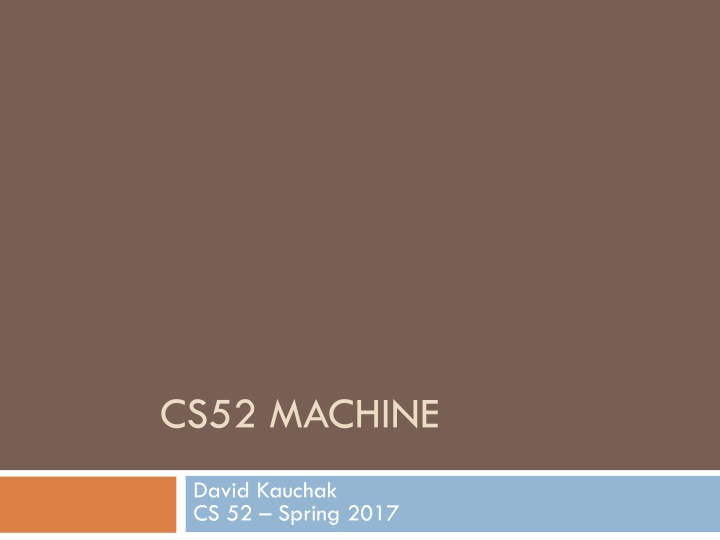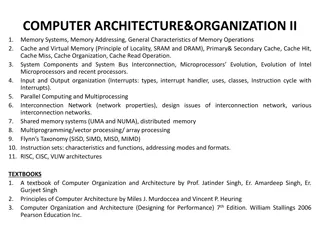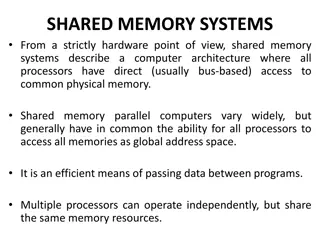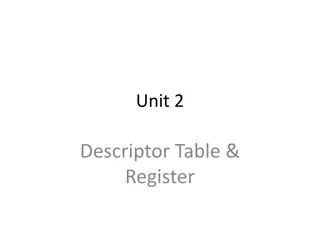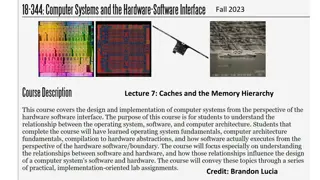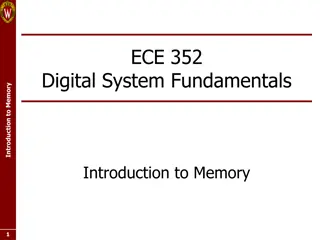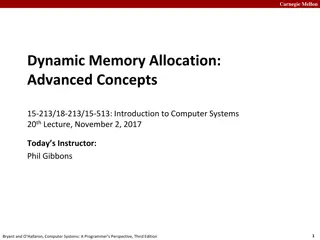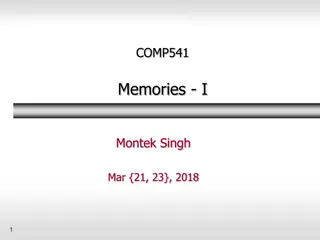Computer Internals and Memory Systems
Delve into the intricacies of computer internals, exploring concepts like CPU, RAM, hard drives, and memory storage. Gain insights into how these components work together to power your device's operations and store vital data effectively.
Download Presentation

Please find below an Image/Link to download the presentation.
The content on the website is provided AS IS for your information and personal use only. It may not be sold, licensed, or shared on other websites without obtaining consent from the author.If you encounter any issues during the download, it is possible that the publisher has removed the file from their server.
You are allowed to download the files provided on this website for personal or commercial use, subject to the condition that they are used lawfully. All files are the property of their respective owners.
The content on the website is provided AS IS for your information and personal use only. It may not be sold, licensed, or shared on other websites without obtaining consent from the author.
E N D
Presentation Transcript
CS52 MACHINE David Kauchak CS 52 Spring 2017
Admin Midterm 1 Assignment 3 Assignment 4
Examples from this lecture http://www.cs.pomona.edu/~dkauchak/classes/cs52/examples/cs52machine/
Computer internals simplified CPU RAM What does it stand for? What does it stand for? What does it do? What does it do?
Computer internals simplified CPU RAM (Central Processing Unit, aka the processor ) (Random Access Memory, aka memory or main memory ) Temporary storage Does all the work!
Computer internals simplified the computer hard drive CPU RAM Why do we need a hard drive?
Computer internals simplified the computer hard drive CPU RAM - - Persistent memory RAM only stores data while it has power
Computer simplified the computer hard drive CPU RAM network media drive input devices display
Inside the CPU CPU processor processor: does the work registers: local, fast memory slots registers Why all these levels of memory?
Memory speed operation access time times slower than register access 1 400 ~million ~billion for comparison 1 s 6 min 1 month 30 years register RAM Hard disk google.com 0.3 ns 120 ns 1ms 0.4s
Memory 010101111000101000010010 RAM What is a byte? ?
Memory 01010111 10001010 00010010 RAM byte = 8 bits byte is abbreviated as B My laptop has 16GB (gigabytes) of memory. How many bits is that?
Memory sizes bits byte 8 kilobyte (KB) 2^10 bytes = ~8,000 megabyte (MB) 2^20 =~ 8 million gigabyte (GB) 2^30 = ~8 billion My laptop has 16GB (gigabytes) of memory. How many bits is that?
Memory sizes bits byte 8 kilobyte (KB) 2^10 bytes = ~8,000 megabyte (MB) 2^20 =~ 8 million gigabyte (GB) 2^30 = ~8 billion ~128 billion bits!
Memory address 0 1 2 3 01010111 10001010 00010010 01011010 RAM Memory is byte addressable
Memory address 0 1 2 3 01010111 10001010 00010010 01011010 RAM Memory is organized into words , which is the most common functional unit
Memory address 32-bit words 0 4 8 ... 10101011 10001010 00010010 01011010 11001011 00001110 01010010 01010110 10111011 10010010 00000000 01110100 RAM Most modern computers use 32-bit (4 byte) or 64-bit (8 byte) words
Memory in the CS52 Machine address 16-bit words 0 2 4 ... 10101011 10001010 00010010 01011010 11001011 00001110 RAM We ll use 16-bit words for our model (the CS52 machine)
CS52 machine CPU instruction counter (location in memory of the next instruction in memory) processor ic r0 holds the value 0 (read only) r1 - - general purpose read/write r2 registers r3
instruction counter (location in memory of the next instruction in memory) ic r0 holds the value 0 (read only) r1 - - general purpose read/write r2 r3
CS52 machine instructions CPU processor What types of operations might we want to do (think really basic)? registers
CS52 machine code Four main types of instructions math branch/conditionals memory control the machine (e.g. stop it) 1. 2. 3. 4.
arguments instruction name
arguments instruction name instruction/operation name (always three characters)
arguments instruction name operation arguments R = register (e.g. r0) S = signed number (byte)
arguments instruction name 1st R: 2nd R: 3rd S/R: register where the answer will go register of first operand register/value of second operand
add r1 r2 r3 What does this do? 1st R: 2nd R: 3rd S/R: register where the answer will go register of first operand register/value of second operand
add r1 r2 r3 r1 = r2 + r3 Add contents of registers r2 and r3 and store the result in r1 1st R: 2nd R: 3rd S/R: register where the answer will go register of first operand register/value of second operand
add r2 r1 10 What does this do? 1st R: 2nd R: 3rd S/R: register where the answer will go register of first operand register/value of second operand
add r2 r1 10 r2 = r1 + 10 Add 10 to the contents of register r1 and store in r2 1st R: 2nd R: 3rd S/R: register where the answer will go register of first operand register/value of second operand
add r1 r0 8 neg r2 r1 sub r2 r1 r2 What number is in r2? 1st R: 2nd R: 3rd S/R: register where the answer will go register of first operand register/value of second operand
add r1 r0 8 neg r2 r1 sub r2 r1 r2 r1 = 8 r2 = -8, r1 = 8 r2 = 16 1st R: 2nd R: 3rd S/R: register where the answer will go register of first operand register/value of second operand
Accessing memory sto = save data in register TO memory loa = put data FROM memory into a register sto r1 r2 ; store the contents of r1 to mem[r2] loa r1 r2 ; get data from mem[r2] and put into r1
Accessing memory sto = save data in register TO memory loa = put data FROM memory into a register Special cases: - saving TO (sto) address 0 prints - reading from (loa) address 0 gets input from user
Basic structure of CS52 program ; great comments at the top! ; instruction1 instruction2 ... hlt ; comment ; comment whitespace before operations/instructions
Running the CS52 machine Look at subtract.a52 - load two numbers from the user - subtract - print the result
CS52 simulator Different windows Memory (left) Instruction execution (right) Registers I/O and running program
1st R: 2nd R: 3rd B: first register for comparison second register in comparison label
beq r3 r0 done What does this do? 1st R: 2nd R: 3rd B: first register for comparison second register in comparison label
beq r3 r0 done If r3 = 0, branch to the label done if not (else) ic is incremented as normal to the next instruction 1st R: 2nd R: 3rd B: first register for comparison second register in comparison label
ble r2 r3 done What does this do? 1st R: 2nd R: 3rd B: first register for comparison second register in comparison label
ble r2 r3 done If r2 <= r3, branch to the label done 1st R: 2nd R: 3rd B: first register for comparison second register in comparison label
- - - Conditionals Loops Change the order that instructions are executed
Basic structure of CS52 program ; great comments at the top! ; instruction1 instruction2 ... label1 instruction instruction label2 ... hlt end ; comment ; comment ; comment ; comment - whitespace before operations/instructions - labels go here
More CS52 examples Look at max_simple.a52 - Get two values from the user - Compare them - Use a branch to distinguish between the two cases - Goal is to get largest value in r3 - print largest value
